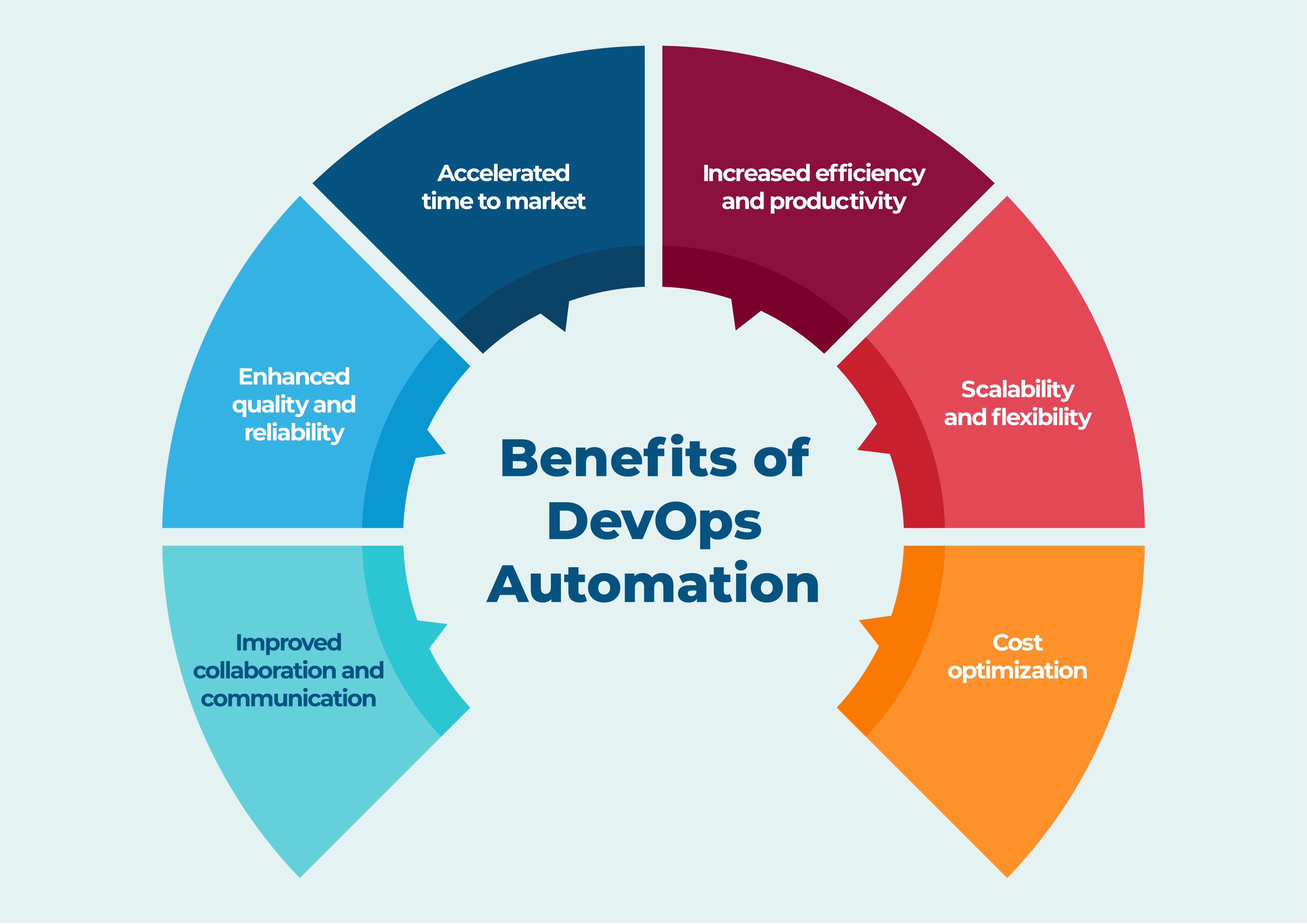DevOps – The Complete Guide
Enhancing the present resources and tools is crucial in today’s constantly evolving world settings. In the competitive business landscape, organizations are continually striving to deliver high-quality software at an accelerated pace. This is where DevOps comes into play.
DevOps is a collaborative approach that combines development (Dev) and operations (Ops) teams to streamline the software delivery process, enhance collaboration and ensure faster time to market. In this comprehensive guide, we will explore the world of DevOps and its key components and benefits and understand the major importance of DevOps automation services.

Understanding DevOps Automation
Answering ‘What is DevOps automation?‘, DevOps automation refers to the use of tools, technologies, and processes to automate various stages of the software development lifecycle (SDLC) and the operations workflow.
It aims to eliminate manual, repetitive tasks, reduce errors and enhance efficiency. DevOps automation encompasses infrastructure provisioning, code compilation and testing, deployment, monitoring, and much more. By automating these processes, organizations can achieve faster, more reliable software delivery.
Key Components of DevOps
Here we will explore the key components of DevOps in depth:
1. Culture and collaboration: The cultural aspect of DevOps promotes collaboration, communication, and shared responsibilities between development and operations teams. By fostering a culture of trust, continuous learning, and accountability, organizations can break down silos and create an environment conducive to DevOps practices.
2. Automation tools: DevOps relies heavily on automation tools to streamline and accelerate the software delivery process. Some popular automation tools include:
- Configuration management tools such as Ansible, Puppet, etc., help manage infrastructure and ensure consistency across environments.
- Continuous Integration (CI) tools like Jenkins, Travis CI, and CircleCI automate the build and integration of code changes from multiple developers.
- Continuous Deployment/Delivery (CD) tools, such as Azure DevOps, GitLab CI/CD, and AWS Code Pipeline, automate the deployment and release of applications to various environments.
3. Continuous Integration and Continuous Deployment (CI/CD): It is a fundamental aspect of DevOps that enables organizations to automate the build, test, and deployment processes. Continuous integration involves regularly merging code changes into a shared repository, ensuring early detection of integration issues. Conversely, continuous deployment automates the release and deployment of code changes to production or staging environments.
4. Infrastructure as Code (IaC): IaC is a practice that treats infrastructure provisioning and management as code. It involves using declarative or imperative code to define and manage infrastructure resources. Tools like Terraform and CloudFormation enable organizations to automate the creation and configuration of infrastructure, making it more scalable, reproducible, and consistent.
5. Monitoring and logging: DevOps emphasizes the importance of monitoring application and infrastructure performance to detect issues and ensure smooth operations. Tools like Prometheus, Grafana, and ELK stack (Elasticsearch, Logstash, and Kibana) enable organizations to collect and analyze metrics, logs and events, providing valuable insights for troubleshooting and optimization.
6. Security and compliance: DevOps teams must prioritize safety and compliance throughout the software delivery process. Security practices such as code scanning, vulnerability assessments, and secure configuration management should be automated to ensure the timely detection and remediation of security risks.
Benefits of DevOps Automation
There is no doubt about the fact that DevOps is highly efficient and beneficial. Listed below are the benefits of DevOps automation
Improved collaboration and communication: DevOps promotes collaboration and communication between development, operations, and other stakeholders. Automation tools and processes facilitate seamless coordination, enabling teams to work together more efficiently.
Enhanced quality and reliability: DevOps automation ensures consistency and repeatability in the software delivery process. By automating testing, code reviews, and deployment, organizations can reduce errors, improve quality and enhance the reliability of their applications.
Accelerated time to market: DevOps automation services enable organizations to deliver software faster, reducing time to market and gaining a competitive edge. By automating manual tasks and streamlining processes, teams can focus on innovation and delivering value to end-users.
Increased efficiency and productivity: Automation eliminates manual, repetitive tasks, freeing up valuable time for development and operations teams. This increases productivity, allowing teams to focus on more critical and innovative work.
Scalability and flexibility: DevOps automation enables organizations to scale their infrastructure and applications more effectively. By using infrastructure as code and automated deployment processes, teams can quickly provision resources and adapt to changing demands.
Cost optimization: Automation helps reduce operational costs by eliminating the need for manual interventions and reducing the risk of human errors. It enables organizations to use resources more efficiently and optimize their infrastructure.
DevOps Strategy
The above information brings us to another crucial question ‘What is DevOps strategy?‘
DevOps strategy refers to the overarching plan and approach adopted by organizations to implement and embrace DevOps principles effectively. It involves defining goals, identifying the necessary tools and processes, and fostering a culture of collaboration and continuous improvement.
A well-defined DevOps strategy typically includes the following:
Assessment and planning: Organizations should assess their current software delivery process, identify pain points and areas of improvement, and establish goals and objectives. This involves understanding the existing culture, evaluating the technical stack, and analyzing the skill sets of the teams involved.
Tool selection and implementation: Selecting the correct set of automation tools and technologies is essential for a successful DevOps implementation. Organizations should evaluate tools based on their specific requirements, compatibility with existing systems, ease of integration, and community support.
Process and workflow design: DevOps requires a shift in processes and workflows to enable seamless collaboration between working teams. This majorly involves defining clear roles and responsibilities, establishing effective communication channels, and implementing CI/CD pipelines and deployment strategies.
Continuous learning and improvement: DevOps is an iterative process that encourages constant learning and improvement. Organizations should promote a culture of experimentation, feedback, and continuous feedback loops to identify areas of improvement and implement changes accordingly.
Azure DevOps Automation
Azure DevOps is a comprehensive set of development tools provided by Microsoft, encompassing version control, CI/CD pipelines, project management, and more. It offers a range of automation capabilities that enable organizations to streamline their DevOps processes on the Azure cloud platform.
Some key features of Azure DevOps automation include:
- Azure Pipelines: Azure Pipelines enables organizations to automate the building, testing, and deployment of applications across multiple platforms and environments. It supports various programming languages, platforms, and integration with popular development tools.
- Azure Boards: Azure Boards provides project management and tracking capabilities, allowing teams to plan, track, and discuss work across the entire development lifecycle. It enables seamless collaboration and visibility, ensuring that projects are delivered on time and within budget.
- Azure Repos: Azure Repos provides version control capabilities, allowing teams to manage and track code changes. It supports both Git and Team Foundation Version Control (TFVC), providing flexibility and scalability for development teams.
- Azure Artifacts: Azure Artifacts is a package management solution that enables teams to create, host, and share packages across their projects. It simplifies dependency management and ensures consistency across the development and deployment processes.
Azure DevOps automation empowers organizations to leverage the power of the Azure cloud platform while implementing DevOps best practices. It provides a unified and integrated environment for managing the end-to-end software development lifecycle.
Challenges in Implementing DevOps Automation
While DevOps automation services offer numerous benefits, implementing it can come with its own set of challenges. It’s important to be aware of these challenges and address them effectively to ensure a successful implementation. Let’s explore some common challenges faced in adopting DevOps automation:
- Tool selection and integration: With a wide range of automation tools available, choosing the right ones can be daunting. It’s crucial to evaluate tools based on their compatibility, scalability, ease of use, and community support.
- Skill set and training: Adopting DevOps automation may require upskilling the existing workforce or hiring professionals with relevant expertise. Providing training and resources to empower teams with the necessary skills and knowledge is essential for successful implementation.
- Security and compliance: Implementing automation without proper security measures can lead to vulnerabilities. Integrating robust security practices and ensuring compliance with industry regulations throughout the DevOps automation process is crucial.
- Resistance to change: Resistance to change from team members or stakeholders can pose challenges during the adoption of DevOps automation. Effective communication, transparency, and involvement of all stakeholders are key to overcoming resistance and gaining support for the transformation.
Addressing these challenges requires a strategic approach, strong leadership, and a commitment to continuous improvement. Organizations can seek the assistance of experienced DevOps automation consulting firms like BuzzyBrains to navigate these challenges and successfully implement DevOps automation.
Conclusion
DevOps automation is a game-changer for organizations seeking to enhance their software delivery capabilities. By embracing automation tools, streamlining processes, and fostering a collaborative culture, organizations can achieve faster time to market and improve their software’s overall efficiency, quality, and reliability.
From the key components of DevOps to the benefits of automation and the importance of a well-defined DevOps strategy, organizations can leverage these principles to drive innovation and stay ahead in today’s competitive market.
At BuzzyBrains, we understand the significance of DevOps automation in empowering organizations to achieve their software delivery goals. With our expert DevOps automation consulting and services, we help businesses navigate the complexities of implementing automation tools and processes. Our team of experienced professionals assists in selecting the right tools, designing efficient workflows, and fostering a collaborative culture to drive successful DevOps transformations.
In conclusion, DevOps automation is not just a buzzword but a transformative approach that brings development and operations teams together to deliver software faster, better, and with higher quality. Contact BuzzyBrains today to embark on your DevOps automation journey and experience the benefits of streamlined software delivery.
